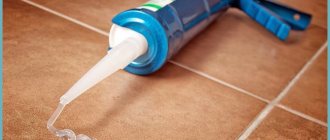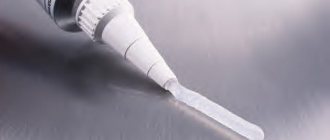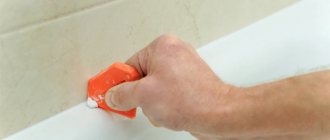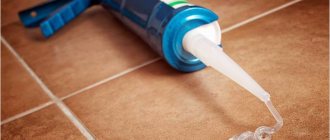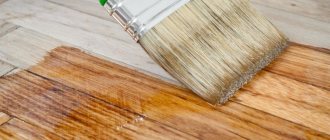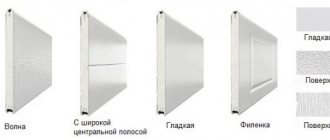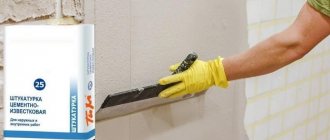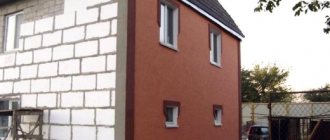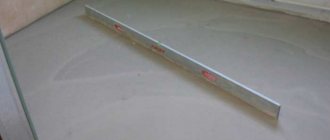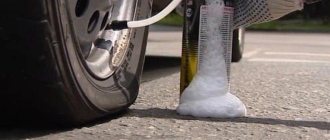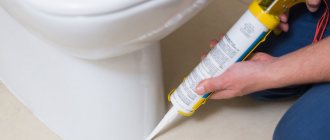Choosing a sealant for the bathroom
How many brands of sealant present on the building materials market today can be used when carrying out renovation work in the bathroom?
Not so much. This is due to the specific microclimate of this room: high humidity, the risk of fungi and mold. Such factors require the use of materials for sealing seams, sealing cracks, which not only would not be afraid of high humidity in the bathroom, but, thanks to their properties, could fight various types of fungi and mold, and would not lose their properties when the temperature changes. The bathroom always has its “weak points”: the joint between the bathtub and the wall, the junction of the shower stall and the tiles on the wall, in the contact areas
screens to the sides of the bathtub, at the junction of the elements of the border, baseboard and tiles, corner. In fact, it is a haven for mold and mildew. If such areas are not sealed, there is a double risk: water that penetrates inside will destroy walls, spoil finishing materials, and dangerous microflora can easily reach people taking a bath, shower, or using the bathroom.
That is why the question arises: what sealant should you use in order not to put your home and the health of those living in it at risk, and to protect them from the harmful effects of fungus and mold?
What problems does bathroom sealing solve?
It is almost impossible to install the bathtub close to the wall: a small gap still remains due to the curvature of the wall, floor, and due to difficulties with the perfect fit of the plumbing. While taking a bath, water will seep into the holes, flow down the wall and onto the flooring.
If the joints are not completely sealed, this will lead to negative consequences:
- water can flood neighbors if there is too much of it;
- the air humidity in the room will increase even more, mold will settle on the walls;
- The seams between the tiles will lose strength and attractiveness: they will become dark, dirty in appearance, then crumble and become unusable within a couple of years.
For these reasons, it is impossible to ignore the implementation of high-quality sealing of seams in the bathroom, and the joints should be sealed both between the bathtub and the wall, and at the shower stall, sink, and toilet. To work, you will need a waterproof sealant based on acrylic, silicone or other components.
Sealing seams in the bathroom
What types of bathroom sealant are there?
An inexperienced consumer can easily get lost in the wide range of silicone, silicate, acrylic, bitumen, rubber, and polyurethane sealants provided. In addition, such polymers are transparent, white, and colored, which can help vary when waterproofing tiles above the bathtub. Only a few of them are suitable for use in the bathroom:
- silicone;
- acrylic;
- silicone acrylic;
- polyurethane (thiokol);
- aquarium
Important: glue marked “sanitary” will definitely suit you for use in the bathroom. It is better to choose just such a product for insulating tiles, seams, and cracks, since it has fungicidal properties.
Silicone sealants
This type of sealant is most popular due to its long service life (up to forty years) and adhesion to various types of materials: concrete, glass, ceramics, PVC. It is resistant to ultraviolet radiation, but dries for at least a day.
Its basis is silicone - an excellent water-repellent material that can withstand temperature fluctuations from -45 to +190 degrees without losing its properties.
Silicone sealant for the bathroom is produced in two types:
- Acidic (acetic). It is affordable, but the negative quality is that during vulcanization, oxidation of metals occurs. Recommended when working with materials that cannot be oxidized (stainless steel, aluminum).
- Neutral (its subtype is sanitary). Corresponds to its name: does not enter into any reactions with adjacent materials, protects against mold and fungi. The most common uses of sanitary silicone are in the bathroom and kitchen. Can be used for acrylic bathtubs, metal surfaces, tiles. By the way, sanitary sealant can stretch twice as much after drying, like a flexible rubber gasket.
Sanitary silicone sealant for the bathroom is heat-resistant, which is another advantage to the characteristic.
The word “sanitary” literally implies protection against something: in this case, the sanitary polymer has protection against fungi and mold.
Disadvantage - it costs more than acidic.
Important: sanitary adhesive must contain at least 50% rubber content and a fungicide against fungus and mold.
Acrylic sealant
Cheap, characterized by good adhesion to materials such as wood, concrete, glass, brick. The problem with using acrylic sealant is that it is not very elastic, i.e. The seam should not be deformed after drying.
In addition, acrylic glue is produced in two types: moisture-resistant and non-moisture-resistant. Naturally, the first option is suitable for the bathroom. Acrylic sealant is good because the areas treated with it can be painted or plastered. Acrylic polymer dries for at least 24 hours.
Tip: if you need an adhesive-sealant to seal the plumbing elements in the bathroom, look for a polymer labeled “For PVC and acrylic.”
Silicone acrylic sealants
Materials of this type combine the properties of both sealants: silicone has moisture resistance and elasticity, and acrylic has strength and durability. These polymers can not only be used as joint putty and tile waterproofing, but also serve as a reliable connector for different materials.
Polyurethane polymers
With their help, the seam can be given strength, elasticity, and durability. Guarantees good adhesion to any building materials used in the bathroom. Not afraid of chemical and mechanical influence, dries in 12 hours. Allowed as an option for repairing old seams where silicone was previously used.
Aquarium glue
In addition to its direct purpose (sealing seams in aquariums), this paste-like polymer functions well in the bathroom to create high-quality sealing of seams, joints, and connections of shower stall elements. Aquarium polymer dries in about 20 hours.
What to look for when choosing
To make the choice of sealant as successful as possible, when purchasing, pay attention to the following:
- High humidity in the bathroom and shower creates excellent conditions for the development of mold, mildew and other biological formations. The composition you choose should become a reliable barrier for these microsubstances.
- The most popular is the silicone composition - it perfectly seals seams, and also seals the joints between the wall and the plumbing. In addition, such compositions are perfect for the process of updating old seams.
- Pay attention to the bathroom: if you have it made of metal, then in this case you need to choose a neutral . An acrylic sealant is suitable for an acrylic bathtub, since it is closer to it in composition.
- In addition to the main polymer, the composition also includes various additives - they are added either to improve technical characteristics or to reduce the cost of the product. Therefore, if there are more than 10% of such additives in the composition, we advise you to refuse the purchase - this sealant may be of dubious quality with a short service life.
- If you are making renovations in a country house where there is no heating in winter, then be sure to finish the bathroom with frost-resistant materials (including sealant).
Terms of use
Before using the polymer to seal joints and seams, it is necessary to perform a number of procedures:
- When the sealing is carried out again, it is necessary to remove the unsuitable glue (remove it from the surface of the tile, bathtub). You can try to carry out this difficult procedure with a stationery knife, carefully cutting the ball on both sides. Do not try to remove the old seam by rolling thin strips from it, because the remaining glue in the depths will not be removed in this way anyway. If it is not possible to completely remove the old polymer, it is better to resort to using a chemical remover. It is correct to do this as many times as each specific situation requires.
Important: if you are going to remove the old layer of sealant using chemicals (aerosols, pastes), take care to protect your hands, eyes and respiratory organs. Forced ventilation is required!
- Before applying glue, the working surface must be thoroughly cleaned, dried and degreased with alcohol or acetone.
- Sealing seams will be more convenient if you cut the tip on the tube at an angle of 45 degrees, screw on the cap, and insert the tube into the gun for installing the sealant.
- Apply glue to the prepared work area in a continuous line, otherwise the whole point of sealing is lost. Remove any remaining polymer using a damp sponge.
- Provide protection from water until the joint is completely dry (from 10 to 24 hours, i.e., as long as the type of sealant requires).
Tip: in order to carefully apply the glue, it is better to use masking tape. Use it to protect the working area of the required width on both sides (by level) and apply the polymer.
To obtain a high-quality result and protect your bathroom from mold, you should act correctly and consistently, while not forgetting about precautions when working with chemicals. Naturally, it is important which sealant you choose for the job.
Application rules: step-by-step instructions
The main rule when working with any materials in a room with plumbing is an initial study of their composition and method of use.
This will not only help you produce high-quality work the first time, but will also save you from rework and unnecessary costs in the future.
And to save time, you need to prepare all the necessary tools and surfaces for work.
Tools and Supplies
To work in the bathroom you will need:
- Gun for sealants (if the composition is in a cartridge, if in a tube, the gun is used as desired)
- Sponge
- Solvent
- Scotch tape for painting
- Soap solution
- Spatula or special nozzle for sealants
The need for all tools is purely at the discretion of the master, but ignoring any of them does not guarantee aesthetic work in the final result.
Surface preparation
The main rule when applying any solutions or compositions to a bathroom or other plumbing fixtures in a room is to carefully prepare the working surfaces where it will be applied.
All old, dilapidated coverings in the room are removed, the surface is cleaned and washed, and be sure to degrease and dry.
Only after all the manipulations have been done in the room do we begin sealing.
In cases with deep cracks, before sealing, first fill them with a sponge, but leave a gap of 5 mm deep for the sealant itself, after the composition has dried, the filler can be removed.
For an even and clean application of the composition, we cover the seam with molar tape, you need to make sure that the tape lies in an even line, and remove it almost immediately after applying the composition itself, until it hardens, otherwise the end result will be ruined.
Preparation of the product
The work with sealant itself is not difficult, but initial training may be required if this is done for the first time. Beginning of work:
- We cut off the tip of the silicone spout at an angle (this will make it easier to apply the composition), but the cut should be slightly larger than the gap, about a couple of millimeters.
- For even application, use a gun (insert the cartridge into the gun and press the lever a couple of times to release air from the spout) You can work
Final processing.
To get the most even seam and minimize further processing of the seam, you need to apply the product by gently smoothly and continuously pressing the gun lever, without sharp jerks along the entire length of the gap, while placing the nose of the sealant as close as possible to the surface to be treated.
The seam should be as uniform as possible, all irregularities should be corrected either with a finger or with special spatulas. Then remove the tape and remove the remaining excess product. If the sealant is used as glue, then the use of spatulas and tape is not necessary.
The product is applied in a convenient way to the back of the material, which is then pressed against the surface for a few seconds.
How long does it take for sealant to dry in a bathroom?
According to the instructions, you cannot use water in the bathroom until the product has completely dried.
But each type has its own time, the exact information can always be read on the packaging, for example, the minimum time for acidic ones is 4-6 hours, neutral ones - 10-12, and there are those that require as much as 24 hours for complete polymerization.
Although the process can be speeded up a little.
For example, ventilation of the bathroom and temperature conditions of no more than +40 will significantly reduce the waiting time for drying in the bathroom.
How to remove sealant from a bathtub
Previously, it was stipulated that it is necessary to remove excess sealant before it dries completely, all because the set composition can only be removed mechanically, for example, with a knife or pumice.
The easiest way is to pry up the seam at the very base where it touches the wall, but if it is not possible to remove it properly mechanically, you can use chemicals, such as acetone.
To do this, the seam is wetted for a few minutes and, after softening, removed with a regular cloth. In addition to available means, there are also a number of specialized ones specifically designed for removal.
These include:
- PENTA 840
- Lugato
- Gasket Remover
- Antisil 770
- Dow Corning OS-2
How to replace sealant in a bathroom
Old, darkened seams that have lost their aesthetic and functional properties must be replaced.
This is not difficult to do; you can verify this by reading the article from the very beginning. But do not forget that any repair begins with complete cleaning of outdated material, carrying out antiseptic work if necessary, and only after that new material is applied.
Types of bathroom sealants and recommendations for selection
The bathroom is a type of room where moisture is constantly present in large quantities, as well as steam and large changes in temperature conditions. It is for this reason that when renovating a bathroom, special moisture-resistant materials are selected for the job, which includes bathroom sealant. In this article, we will look at what types of sealants there are and which ones are best used for waterproofing joints indoors, based on reviews and recommendations from experts.
Modern sealants for the bathroom are very popular and many renovations cannot be done without this material. They are used mainly for sealing joints between the bathtub and adjacent wall surfaces, as well as for gluing decorative corners.
It is known that a large accumulation of dampness in some places in the bathroom not only leads to the destruction of the finishing material, but also creates a favorable environment for the growth of mold, which saturates the air with its pores and can cause disease. This is why bathtub sealant is used against mold, which blocks the access of moisture to areas such as the space under the bathtub. In this place, ventilation is very poor or non-existent, and this creates an ideal environment for the development of bacteria in the presence of moisture.
No fungus and no leaks: choosing the best sealant for the bathroom
A high-quality sealant for the bathroom (in other words, sanitary or plumbing sealant) will allow you to forget for a long time about the streams of water flowing from under the bathtub or shower stall, and, if necessary, will protect the tile joints from moisture and fungus (although it is more logical to use a special grout for this), and will do it for a long time. Do annoying water leaks appear after washing? Well, it's time to go to the store for sealant and fix the leaks. The main thing is to make the right choice this time.
We will traditionally write about the features of different types of sealants in the conclusion, and now we will traditionally go through the windows of construction stores.
What is silicone sealant
Before choosing a sealant, you need to find out what types there are and in what places they are used. Today, a sealant is a liquid viscous substance that basically contains a polymer material as a binder for various modifying components included in its composition. Depending on the polymer base, sealants can be:
- silicone;
- bitumen;
- acrylic;
- rubber or rubber;
- polyurethane;
- thiokol.
For your information. Not all of the listed materials are used in the bathroom. The most commonly used sealants are polyurethane, acrylic or silicone for bathrooms.
The physical characteristics of sealants are given by the composition of their main filler, and various additional components only enhance certain qualities of the substance. Some of the listed types are not recommended for use in the bathroom as waterproofing of seams; therefore, below we will only consider sealant for seams in the bathroom and other work in the bathroom.
Silicone
The sealant is based on silicon. The properties of the durable substance were enhanced with the help of polymers and plasticizers. The viscous silicone rubber compound hardens at room temperature.
Characteristics of the substance
The products are divided into 2 groups based on their components. Acidic (acetate) types smell strongly of vinegar before they harden; you can recognize them by the letter “A” on the label. The models oxidize when applied to metal, so they are not suitable for working with cast iron and steel bathtubs. Neutral substances are more versatile in use, but are more expensive than the first varieties.
If you don’t know which silicone sealant is best for the bathroom, we recommend choosing sanitary types. The label should indicate that the product is water-resistant or can be used in wet conditions. One-component formulations are ready for use, so there is no need to mix ingredients.
Product for use in the bathroom Source sovety-vannoy.ru
Silicone sealants have high adhesive properties. The product adheres equally well to plastic and stone, metal and glass. The substance is used to seal joints on surfaces made of different materials. The composition is adjacent to drywall and drainpipes.
The silicone-based sealant dries in 2 stages. The first stage, when you can still adjust the weight, takes place within 30 minutes. Hardness gains gradually. Depending on the level of humidity and thickness of the layer, the period varies from 6 hours to 2 days.
Substance for insulating joints Source postroy-sam.com
The best sealant for an acrylic bathtub will contain silicone. After drying, the substance forms a dense and elastic seam. The strip does not crack when moving or under heavy load, so it is suitable for processing joints between walls and plumbing fixtures. After polymerization, the product shrinks by only 2%.
Fungicides are added to sanitary sealants during production. Antibacterial components kill microorganisms that develop in humid conditions. When working with such species, mold and mildew will not appear.
Main types of bathroom sealants
Next we will describe which sealant is best to use for working in the bathroom and sealing butt joints. Of course, the best option would be a moisture-resistant sealant, which includes:
- silicone;
- acrylic;
- acrylic-silicone;
- polyurethane.
Each of these materials has its own characteristics and is suitable for different cases, so it’s up to you to decide which sealant to choose based on the circumstances.
Silicone sealant
Silicone is a sealant for bathroom tiles, which is mainly used for sealing joints between tiles and has excellent water-repellent characteristics. This material can withstand sudden temperature changes and does not lose its physical properties. This type is also called sanitary sealant because it is inert to most chemicals. It can be used in rooms with a constant temperature of -50 to 180 degrees Celsius.
Important. Sanitary sealant for the bathroom can be of two types, acidic and neutral.
The acidic composition has a characteristic pungent odor, similar to the smell of vinegar, and is much cheaper than the neutral one. However, this composition, when interacting with metals, causes oxidation, so they can be used on a metal surface with a protective coating or stainless steel. Neutral silicone-based bathroom sealant costs a little more than its counterpart, but it does not have the same reaction with metals as an acidic one and does not have a pungent odor. This composition is often used as a sealant for acrylic bathtubs.
Acrylic sealant
This composition does not have any strong odors, sometimes even odorless. Its cost is lower than its silicone counterparts, but this acrylic bathroom sealant cannot be used in places that may be subject to minor mechanical stress or deformation during operation. This is due to the fact that when hardened, this material has no elasticity and begins to crack when deformed.
For your information. The acrylic composition is also called antifungal sealant, since it contains components that prevent the emergence and development of pathogenic microflora. However, due to its properties of fast hardening and providing a strong joint, it is often used as a floor sealant.
Acrylic-silicone sealants
This waterproof bathroom sealant combines the best qualities of the two materials described above, since it simultaneously provides protection from moisture, withstands large temperature changes and, when cured, retains elasticity, which allows it to withstand tightness under small deformation loads. In color, it is most often a white sealant and can be used both for sealing tile joints and for sealing the joint between the bathtub and the wall.
For your information. The acrylic composition has good adhesive qualities and is often used as an adhesive sealant for the bathroom. Manufacturers also produce this type of material in various colors, which allow you to choose the desired color for sealing tile joints.
Polyurethane sealants
Polyurethane bathroom sealant is similar in physical properties to silicone, but it has high adhesive qualities and can be used for gluing decorative corners. This is a transparent sealant and is very often used as a repair material for tile joints, as well as butt joints that were previously filled with silicone sealant.
Basic requirements for sealants
When choosing a mixture for external use, more attention should be paid to its technical characteristics. The main requirements of silicone sealants include:
- ability to interact with a variety of building materials;
- increased density of the solution, allowing the mixture not to spread during use;
- water resistance, which is of particular importance in rainy areas;
- ability to interact with different temperatures, from extremely low to extremely high.
Of course, each individual silicone exterior sealant only meets part of all the requirements. However, this is more than enough to perform a certain type of work. Thus, there are no completely universal mixtures.
How to choose the right sealant
If you want to choose the best sealant for sealing tile seams or the joint between the bathtub and adjacent surfaces, then when going to the store and choosing the right material, consider the following recommendations from experts:
- the composition must first of all have moisture-resistant characteristics, since there are compositions of sealants without water-resistant properties and they differ only in the corresponding recording on the tube;
- try to buy products that contain antibacterial additives. Of course, such a sealant will cost a little more, but it’s worth it;
- Pay attention to how much the sealant costs. A good sealant cannot be cheap, and if you see the material you need at a significantly reduced price, then you are looking at either an outright fake or the composition has expired;
- try to buy brands from trusted manufacturers. Today, the most trusted ones are such domestic ones or “Moment”. To lay plastic corners, choose a material labeled “For PVC and acrylic products.”
Having studied the material proposed in the article, you already know which sealant to use for your needs. And to consolidate the material, we suggest you watch the video material attached below.
The best polyurethane sealants
These are waterproof and noise-reducing materials for sealing joints and installation gaps. They are made by mixing an elastomer with various additives that expand when exposed to air and form a dense foam mass. Polymers are not prone to the formation of fungus and plaque, but are destroyed by sunlight.
Soudal Soudaflex 40 FC white 310 ml - for doorways
This is the best polyurethane sealant for sealing the installation gap when installing entrance and interior doors, because it has a voluminous air mass that fills wide cracks well.
The Belgian product is available in a 310 ml tube and is intended for a construction pistol. The substance is frost-resistant, so it does not collapse when exposed to negative temperatures.
Pros:
- stored up to 12 months;
- will maintain integrity even when the box vibrates in the opening with a deformation mobility of 20%;
- sticks to stone, concrete, metal, wood;
- can be used even in bad weather from the street side at -1 degree;
- has no smell;
- withstands temperature changes from -30 to +90 degrees after installation;
- It insulates the opening well from noise.
Minuses:
- cost from 315 rubles;
- requires preliminary abundant wetting of the surface;
- the nozzle gets heavily clogged and the gun gets dirty, which requires washing;
- Can only be used in conjunction with a mounting gun.
Sealants to protect your bathroom
It is impossible to dispute the fact that there is always high humidity in the bathroom, as this is due to the specifics of this room. A warm and humid environment creates favorable conditions for the proliferation of microorganisms, which contribute to the destruction of building materials and lead to the formation of mold. Even good bathroom ventilation is not able to block all the ways for microbes to multiply; only careful insulation of all seams and joints using a sealant containing substances that destroy these microorganisms will allow you to solve this problem.
Features of use
Before using sealant, take into account the following usage features:
- Room humidity. When applying sealant, it is important to take into account the conditions of its use, which are specified by the manufacturer. The concentration of humidity in the room plays a significant role; if it exceeds the permissible threshold, the sealant may not tightly seal the required area, which will lead to the formation of condensation, the appearance of fungus and, in the worst case, to leakage and the need to redo the work.
- Ventilation methods. The better the room is ventilated, the less likely it is that condensation, germs and fungi will form.
- Application technique. It is important to follow all instructions for preparing the surface for sealing, application methods and further use.
- Application area. Before purchasing this or that sealant, you should pay attention to the materials of the joining surfaces.
Types of polymer sealants for the bathroom
Types of polymer sealants
A good silicone sealant is not afraid of temperature changes - from 50 to + 200 degrees Celsius. Good adhesion to most materials, neutral to UV rays and has a long service life of up to 40 years.
Acid silicone sealant cannot be used with metals, neutral one can, but it is more expensive.
Acrylic - can be moisture-resistant or non-moisture-resistant; the seam made from this sealant is not elastic enough. Undoubtedly, moisture-resistant is more suitable for the bathroom; it completely hardens within a day, just like silicone is not afraid of temperature and ultraviolet radiation.
The best sealant for the bathroom is silicone-acrylic; for aquarium it is as elastic and durable as the polymers from which it is made. Moreover, as a silicone adhesive-sealant, it is used in bonding surfaces and has no equal in durability and elasticity.
Polyurethane – good adhesion to materials, the seam made from it is elastic and durable, and is not afraid of mechanical stress. It lends itself well to painting, the drying time of the sealant is 8 hours with a one-millimeter layer thickness.
Polyurethane
Sealants are made from viscous polymer components of synthetic origin. Polyurethane types are designed for use under extreme conditions and under heavy loads. To improve characteristics, various additives are added to the composition.
Features of the product
Polyurethane varieties are considered one of the best sealants for the bathroom. The substances combine the functions of adhesive and insulating agents. Elastic properties reach 99%, which is higher than that of silicone options. Under any mechanical stress, corners and seams (old, new) will remain sealed. Sanitary models are often used to seal water pipe outlets and for gluing all types of surfaces.
Polyurethane sealants are resistant to vibration and corrosion. When used in damp conditions, the insulating qualities increase. The characteristics of the substance resemble polyurethane foam. After application to the surface, polymerization processes are activated, as a result of which the product dries quickly.
Elastic look for the bathroom Source decorstudia.com.ua
How to apply sealant to a bathtub?
To apply end-to-end sealant to a bathtub, try to adhere to the following instructions:
- We clean the bathtub from dirt and dampness, then dry it and the walls around it.
- We degrease the joints that are to be sealed.
- Apply masking tape to define the boundaries of the seam and make it even.
- We cut off the tip of the cartridge or tube at a certain angle, on which the width of the seam will depend.
- By squeezing the pistol grip or pressing on the tube, we apply an even seam at the junction of the bathroom with the walls using uniform movements.
- To straighten the seam, dip your finger in a soapy solution and run it along the joints.
If the distance is large enough, up to 3 cm, it is sealed with ceramic skirting boards. There are three ways to do this:
- buy special ceramic borders and use them as skirting boards;
- if you still have the material that was used to cover the bathroom walls, then this will be the best option for ceramic tiles;
- The most time-consuming method is to cut out the desired sample from the tile yourself.
First, if the gap is large, it is recommended to seal the joint with polyurethane foam. Then you can, having made a cement-sand mortar, lay the tiles, trying to maintain an angle of 45 degrees. It will be even better if you manage to lay out the junctions of the walls and floor in the bathroom in the same way.
A cheaper way to protect your bathroom
There is a cheaper way to protect the bathroom - using plastic skirting boards or plastic corners with rubber edges, they must be installed with liquid nails glue. The elasticity property of the plastic material makes it possible to differentiate the shifts of the base of the bathtub that are possible during its movements. Pre-treat all joints with silicone, then seal with corners. If the corners come off, the waterproof sealant will block the further path of water.
You can use self-adhesive tape to protect the seam in the bathroom. The tape is available in different widths, but it must be glued following the recommendations, otherwise it will not last long. To avoid this, you need to use liquid nails glue or silicone sealant.
Plastic bath border
If such work needs to be done in a bathtub with wooden floors, then you can use a special sealant for wood. It optimally performs compensation actions due to its high expansion coefficient.
What security measures are in place?
When using these chemicals, you need to take safety measures in the form of: rubber gloves so that the substance does not get on your hands, a respirator and good ventilation in the bathroom.
Rubber gloves for working with sealant
To protect tiles and other surfaces from substances getting on them, you need to use masking tape.
Removing sealant from the surface of the bathtub
Before work to protect the bathroom, sometimes you have to remove old sealant or clean the bathtub of new, but already dried silicone. To remove the sealant from the bathtub, use a sharp scraper and brush. Having selected the slope of the scraper, cut off the old sealant with sharp and quick movements of the hand, and sweep away the removed pieces of silicone with a brush.
You can clean the sealant from the bathtub using white spirit, but there is a danger of damaging the product, and if it has been painted, the paint will be removed along with the silicone.
Foam-840 is another substance used to remove sealant from a bathtub. With this composition, silicone is completely destroyed and does not damage the product. If a film remains on the product, it is recommended to remove it with acetic acid.
How to prevent mildew and mold in the bathroom
The first measure when detecting small damp spots is to treat them with hydrogen peroxide or table vinegar. When you find fungus on the sealant in the bathroom, to get rid of this scourge you need to:
- ventilate the room by opening the windows completely and it is advisable to have “hinged” plastic windows;
- do not close the bathroom, leave a gap in order to equalize the humidity and temperature;
- Treat contaminated surfaces with a special agent down to the concrete or brickwork.
When you see mold on the sealant in the bathroom, you can use folk remedies:
Treat the area with creosote or a solution of ten liters of water with one kilogram of copper sulfate, or 1.5 kg of sodium fluoride, also with a solution consisting of half a kilogram of copper sulfate and two liters of acetic acid per ten liters of water.
Curb tape sealing technology
Bathroom sealing tape comes in a variety of widths and colors. When choosing a strip border, you must take into account that its width should be at least 10 mm greater than the width of the slot. It’s better not to save money and install a larger strip.
The seal is glued using the following technology:
Surface preparation: cleaning, degreasing and drying. Cutting the tape into three strips with an overlap of 1.5 cm on the side elements. Bending the border along the length along the notches. Press the self-adhesive tape onto the joint.
Interesting option
Sealing water pipes in the bathroom
When sealing the bathtub itself, we must not forget about the work to eliminate leaks in the water supply and sewerage pipes that are located in this room. In this case, special silicone sealants are used for sewer pipes of two types - acidic and neutral. The latter are suitable for all surfaces and aqueous media, the former are not suitable for interaction with acids. Silicone sealant is used not only for sealing plastic pipes, but has also proven itself to be excellent for sewer pipes made of cast iron.
In bathrooms, sanitary sealants are used, which have high adhesive properties and are used to protect seams in the gaps of plumbing fixtures and walls.
The same type includes plumbing pipe sealant, which is used to protect the connections of individual pipeline elements. They are designed to maintain high seal protection at both low and high pressure, and also provide excellent high temperature sealing in pipe joints.
Features of the material
The basic component in the manufacture of this type of material is silicone rubbers - viscous compounds, the main chemical element of which is silicon. Thanks to various additives and additives, silicone sealants can differ significantly in physical properties, color, ductility, and characteristics of interaction with surfaces. At the same time, they retain their main inherent advantages:
- good adhesion to most materials;
- dense structure without pores and cavities;
- ability to work at high and low temperatures (total range from -50 to +300°C);
- high elasticity rates;
- chemical inertness after curing;
- resistance to ultraviolet spectrum of sunlight and lighting devices.
Together with a wide range of visual designs (various colors, as well as their complete absence), these properties have provided silicone sealants with enormous popularity in construction, repair, automotive and other areas.
Most construction sealants are packaged in plastic tubes with a spout and a movable bottom for use in matching pistol-type syringes. For closed devices, it is permissible to use materials in soft packaging (foil bags). Automotive sealants are often produced in tubes, from which they are squeezed out by hand.
Main types of sealant
The sealant is a mixture of polymer, filler and hardener.
Depending on what polymer the product is based on, sealants come in several types: silicone, acrylic, polyurethane and a combination version.
Compositions of different types have their own advantages and disadvantages, and features of application.
Silicone acid and neutral
Silicone-based sealants are among the most popular. They go well with any type of material: ceramics and glass, wood and metal, concrete and polycarbonate.
The undeniable advantages of silicone sealants include:
- resistance to moisture;
- ability to easily tolerate high temperature amplitudes, the range of which can vary from -50° to +200°C;
- resistance to aggressive UV rays;
- long service life, which can reach about forty years.
The material has an elastic structure, due to which the fibers can elongate by 900% when stretched. It shrinks by no more than 2%.
Silicone-based compositions are divided into two groups:
- Single-component - used for household purposes. They are characterized by the fact that hardening occurs at the moment of contact with air.
- Two-component - used in the industrial sector. Hardening of compositions of this type occurs upon contact with a “catalyst”.
If when using two-component compositions there are no restrictions on the thickness of the putty, then in household one-component sealants hardening is achieved only if the layer of material does not exceed 2-15 mm.
Household one-component compositions, depending on the type of vulcanizing agent, are presented in two types:
- acidic - acid acts as a catalyst;
- neutral - alcohol or ketoxime acts as a vulcanizer.
Acidic ones are also called “acetic” due to their characteristic odor. They are used to work with ceramics, wood and plastic. Since acid compounds can oxidize alloys and metals during the vulcanization process, they are chosen for treating surfaces that are resistant to rust.
In other cases, preference is given to neutral analogues. They are able to withstand significant temperatures and have a high level of bacterial protection.
The main thing to consider when choosing such compositions is the color, which can be predominantly white or transparent. This will minimize dissonance when installing a bathtub or installing a shower stall with transparent walls.
The popularity of silicone sealants and their demand for arranging bathrooms is justified by an impressive list of positive qualities, these are:
Moisture-resistant and non-moisture-resistant acrylic
Acrylic polymer-based compounds adhere well to mineral surfaces such as plaster, brick or concrete.
The main advantages of acrylic compositions:
- have a light texture;
- resistant to UV radiation;
- able to withstand temperature fluctuations from -25° to +80°C;
The popularity of sealing compounds of this type lies in a good external effect with fairly high performance parameters against the backdrop of an affordable cost.
The only drawback of acrylic sealants is the low degree of elasticity. Therefore, it is better to use them for treating those areas of the bathroom whose surface is not subject to deformation.
In addition, if such a composition is handled incorrectly, sloppy streaks can easily form, which can be quite problematic to get rid of.
Acrylic sealants do not contain organic solvents. And therefore they are absolutely safe for human health. You can work with them even without any protective equipment. Acrylic sealants harden within 24 hours.
Silicone acrylic sealants
There are also combined options available on sale - silicone-acrylic sealants. They successfully combine the advantages of each of the types described above separately.
They are often used as glue when it is necessary to join surfaces.
Polyurethane - an improved chemical product
Compositions of this type are chosen for professional construction and major repair work. Polyurethane easily eliminates the defect in cases where previously sealed seams are no longer satisfactory.
Polyurethane sealants are famous for their high resistance to mechanical and chemical influences. This effect is achieved by adding rubber and various types of plasticizers to the raw material. Due to the aggressiveness of some components, it is necessary to work with polyurethane compounds only in protective equipment.
Separately, it is worth highlighting sanitary sealants, which contain an antiseptic agent. Thanks to this, in addition to the main function - a protective barrier, silicone sealants prevent the appearance and spread of mold colonies in the bathroom.
Kinds
Sealants, like any building material, are divided into types depending on their composition, although most of them are based on polymers, plasticizers, fillers and hardeners.
Silicone
One of the most popular types used for rooms with high humidity is silicone sealants.
It has proven itself not only for its reliable adhesion to any smooth coatings (whether glass or ceramics), but also for its increased resistance to moisture and temperature changes. Silicone sealants can also be divided into two types:
- ACID (acetic). The main difference is the price, it is one of the lowest in its range, but it must be taken into account that this type of sealant cannot be used on surfaces made of metal, stone, lime-based plaster, or mirrors. You can distinguish them by their packaging; it will definitely have the letter symbol “A” on it, and working with it is accompanied by a corresponding smell.
- NEUTRAL. The price of these sealants is already higher, but this fully covers their versatility. Unlike acidic, “NEUTRAL” sealant is resistant to higher temperatures, up to +500 degrees, and can be considered heat-resistant. They can be recognized by the letter symbol “N” and are practically odorless.
Acrylic
Let’s immediately clarify this point: among acrylic sealants there are types that are both resistant to high humidity and those that are not, therefore, the latter are absolutely not suitable for use in the bathroom. Among the advantages of use are the following:
- neutral smell
- resistance to fading and UV
- low price threshold
- admissibility of opening paintwork on top of itself
Even taking into account all the advantages, one cannot help but mention such disadvantages as low elasticity (which subsequently leads to microcracks and leaks) as well as rather poor adhesion to ceramic coatings, mirrors and other finishes.
And the temperature range is not large, only -25 to +80.
Polyurethane
The most durable sealant in the entire range. Gives a lasting, and what is not unimportant, long-wearing result. It is used both for sealing seams and for fastening various elements, even on smooth surfaces.
But when working with such materials, it is necessary to use personal protective equipment and ventilate the room, as they are toxic.
Silicone-acrylic
These sealants combine the best properties of both types, from water resistance to durability.
It is not afraid of temperature changes and can be suitable for outdoor work. The name also makes clear the composition of the components.
Sealants with MS polymers
Thanks to a series of experiments, a favorite of its kind was developed, a sealant containing an organosilicon group.
The price of such sealants is already much higher than others, which is why for a long time it was considered exclusively industrial.
Currently, these products are gaining increasing popularity in household work and for good reason:
- temperature range is not limited
- complete absence of odor
- Wear resistance up to 10 years
- increased strength due to polymer vulcanization from contact with water
- environmentally friendly
- safe for all types of finishing materials
- can be coated with paintwork
Composition and properties of sanitary sealant
For installation and repair work in the bathroom, sanitary sealant is most often used. It is a dense viscous mass.
The main components of silicone sealant for the bathroom are:
- base , the role of which is performed by silicone rubber;
- amplifier - determines the level of strength and viscosity of the material;
- adhesion primer – determines the reliability of adhesion of the composition to the surface being treated;
- plasticizer – increases the elasticity of the material;
- vulcanizer - a substance that converts the primary form of sealant in the form of a paste into a structure resembling plastic rubber.
In addition to the main components, to improve performance, the sealant may contain various types of fillers, for example, quartz flour, glass dust or chalk, as well as extenders and dyes.
The scope of application of sanitary sealant is quite wide:
- sealing joints;
- gluing surfaces;
- insulation of new and renewal of old seams;
- sealing of communications pipe outlets;
- sealing parts that will be exposed to high temperatures.
In an effort to expand the scope of application of the material, manufacturers add fungicides to the composition. These components are capable of destroying mold spores and preventing the appearance of fungus, which is especially important when it is necessary to seal joints in rooms characterized by high humidity.
The best sealant for the bathroom Moment Germent Sanitary
Our rating of bathroom sealants is headed by the silicone composition Moment Germent Sanitary 85 ml. Designed for sealing joints in any wet areas, and is also used for outdoor use.
See where it's cheapest >>>
Moment Germent Sanitary
Moment Germent Sanitary
- surface drying time – 15 minutes;
- color options – white, colorless;
- packaging – plastic tube;
- volume – 85 ml.
The sealant contains fungicides - anti-mold substances that will limit the appearance of fungus in the shower stall, toilet, etc., so the product belongs to the sanitary class. But this same substance limits its scope of application - the composition cannot be used for aquariums.
The sealant is one-component, ready for use immediately. Hardens in a humid atmosphere. It can be applied to any non-porous surfaces without prior priming, but they must first be cleaned and degreased.
The optimal application temperature is from +5 to +40 degrees C. It is possible to work in colder conditions, but the surface must be free of ice and condensed moisture. After curing, it is used in the ambient temperature range from minus 40 to +150 degrees C - this plug covers all practically arising situations.
The total drying time depends on the thickness of the layer - the process occurs at a speed of 2 mm/day. Upon delivery, the tube is additionally packaged in a plastic blister with instructions for use written in Russian in a clear format. Included is a key for squeezing out remaining glue.
pros
- optimal volume for arranging one room;
- reasonable cost and high quality;
- packaging allows you to save the contents until the next one-time work;
- UV resistant.
Minuses
- pungent odor before drying.
